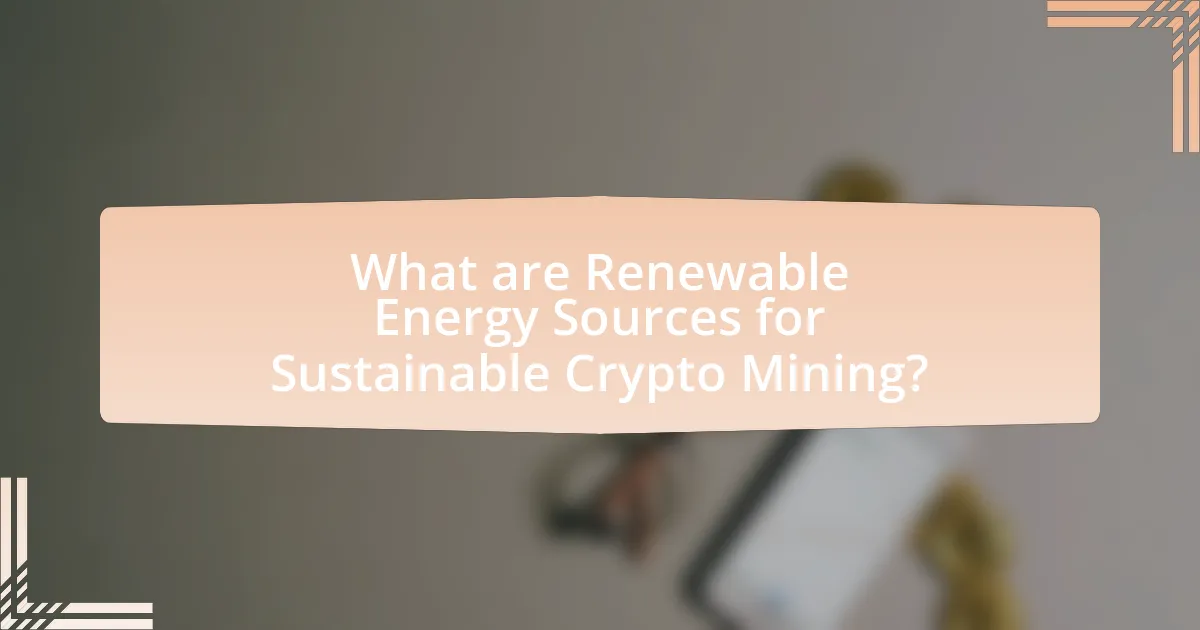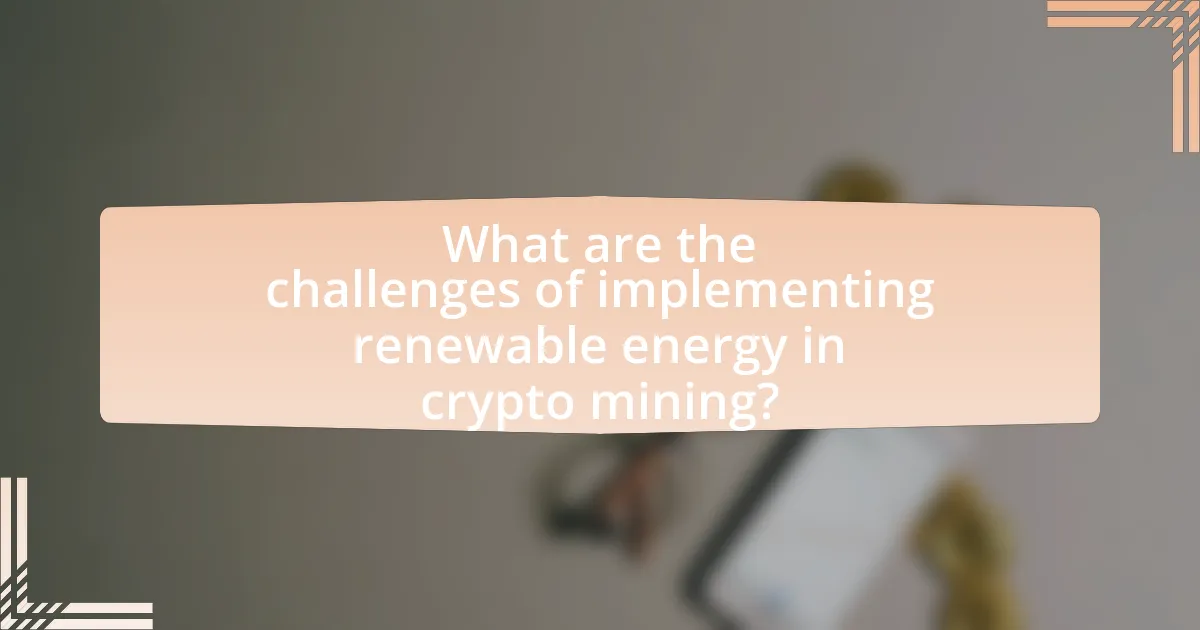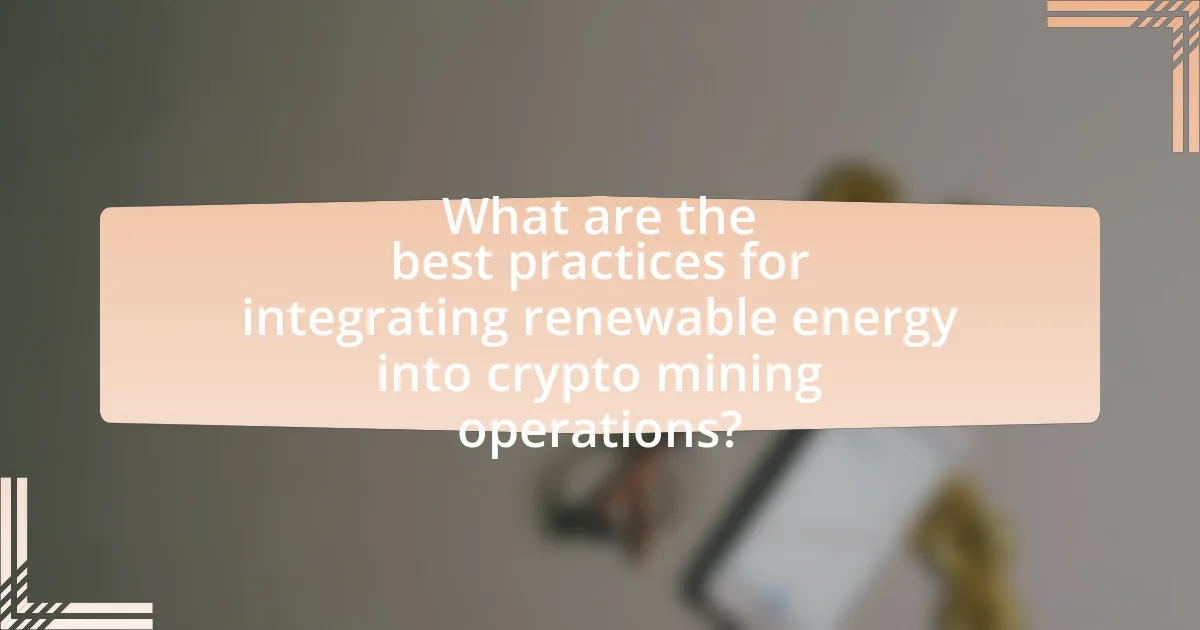Renewable energy sources, including solar, wind, hydroelectric, and geothermal energy, are essential for achieving sustainable crypto mining practices. These energy alternatives significantly reduce the carbon footprint associated with traditional mining methods, which often rely on fossil fuels. The article explores how renewable energy contributes to sustainability in the crypto industry, the types of renewable sources commonly used, and the economic and operational challenges miners face when transitioning to these greener options. Additionally, it discusses the impact of local regulations, best practices for integrating renewable energy, and emerging trends that shape the future of crypto mining.

What are Renewable Energy Sources for Sustainable Crypto Mining?
Renewable energy sources for sustainable crypto mining include solar, wind, hydroelectric, and geothermal energy. These energy sources provide a cleaner alternative to fossil fuels, significantly reducing the carbon footprint associated with cryptocurrency mining. For instance, a study by the International Energy Agency (IEA) indicates that renewable energy can power up to 80% of Bitcoin mining operations in regions with abundant resources, such as Iceland for geothermal and Canada for hydroelectric power. This shift not only promotes environmental sustainability but also enhances the economic viability of mining operations by lowering energy costs.
How do renewable energy sources contribute to sustainable crypto mining?
Renewable energy sources contribute to sustainable crypto mining by providing a cleaner, more efficient power supply that reduces carbon emissions associated with traditional energy sources. For instance, using solar, wind, or hydroelectric power for mining operations significantly lowers the environmental impact, as these sources generate electricity without emitting greenhouse gases. According to a study by the Cambridge Centre for Alternative Finance, approximately 39% of Bitcoin mining was powered by renewable energy in 2021, demonstrating a growing trend towards sustainability in the industry. This shift not only helps mitigate climate change but also enhances the long-term viability of crypto mining by reducing reliance on fossil fuels, which are subject to price volatility and regulatory scrutiny.
What types of renewable energy sources are most commonly used in crypto mining?
The most commonly used renewable energy sources in crypto mining are hydroelectric power, solar energy, and wind energy. Hydroelectric power is favored due to its ability to provide a consistent and large-scale energy supply, particularly in regions with abundant water resources. For instance, in 2021, it was reported that over 60% of Bitcoin mining in China utilized hydroelectric power during the rainy season. Solar energy is increasingly adopted as mining operations seek to reduce costs and carbon footprints; installations of solar panels have surged, especially in sunny regions. Wind energy is also gaining traction, with some mining facilities being set up in areas with high wind potential, contributing to a more sustainable energy mix. These renewable sources not only help in reducing the environmental impact of crypto mining but also provide cost-effective energy solutions.
How does the use of renewable energy impact the carbon footprint of crypto mining?
The use of renewable energy significantly reduces the carbon footprint of crypto mining. By utilizing sources such as solar, wind, and hydroelectric power, crypto mining operations can operate with minimal greenhouse gas emissions compared to those relying on fossil fuels. For instance, a study by the Cambridge Centre for Alternative Finance found that Bitcoin mining powered by renewable energy sources can lower carbon emissions by up to 99% compared to traditional energy sources. This shift not only mitigates environmental impact but also promotes sustainability within the crypto industry.
Why is sustainable crypto mining important?
Sustainable crypto mining is important because it significantly reduces the environmental impact associated with traditional mining practices. Traditional crypto mining, particularly Bitcoin mining, consumes vast amounts of electricity, often sourced from fossil fuels, leading to high carbon emissions. For instance, a study by the Cambridge Centre for Alternative Finance found that Bitcoin mining alone accounted for approximately 0.5% of the global electricity consumption in 2021. In contrast, sustainable crypto mining utilizes renewable energy sources such as solar, wind, and hydroelectric power, which not only lowers carbon footprints but also promotes energy efficiency. By transitioning to sustainable practices, the crypto industry can align itself with global efforts to combat climate change and foster a more environmentally responsible technological landscape.
What are the environmental impacts of traditional crypto mining?
Traditional crypto mining has significant environmental impacts primarily due to its high energy consumption and carbon emissions. The process of mining cryptocurrencies like Bitcoin requires substantial computational power, leading to electricity usage that can exceed that of entire countries; for instance, Bitcoin mining alone consumed approximately 97 terawatt-hours (TWh) in 2021, comparable to the energy consumption of the Netherlands. This energy demand often relies on fossil fuels, contributing to greenhouse gas emissions. A study by the Cambridge Centre for Alternative Finance found that around 56% of Bitcoin mining operations are powered by fossil fuels, exacerbating climate change. Additionally, the mining process generates electronic waste, as specialized hardware becomes obsolete quickly, further straining environmental resources.
How can sustainable practices in crypto mining benefit the industry?
Sustainable practices in crypto mining can significantly benefit the industry by reducing environmental impact and enhancing energy efficiency. By utilizing renewable energy sources such as solar, wind, and hydroelectric power, crypto mining operations can lower their carbon footprint, which is crucial given that traditional mining methods contribute to high greenhouse gas emissions. For instance, a study by the Cambridge Centre for Alternative Finance found that Bitcoin mining’s energy consumption could be reduced by up to 75% if powered entirely by renewable energy. This shift not only aligns with global sustainability goals but also attracts environmentally conscious investors and users, ultimately fostering a more positive public perception of the crypto industry.

What are the challenges of implementing renewable energy in crypto mining?
The challenges of implementing renewable energy in crypto mining include high initial costs, intermittent energy supply, and infrastructure limitations. High initial costs arise from the investment required for renewable energy technologies, such as solar panels or wind turbines, which can be significant compared to traditional energy sources. Intermittent energy supply is a challenge because renewable sources like solar and wind are not always available, leading to potential disruptions in mining operations. Infrastructure limitations refer to the need for adequate energy storage solutions and grid connectivity to effectively utilize renewable energy, which may not be present in all regions. These factors collectively hinder the widespread adoption of renewable energy in the crypto mining sector.
What are the economic barriers to using renewable energy for crypto mining?
The economic barriers to using renewable energy for crypto mining include high initial investment costs, fluctuating energy prices, and limited availability of renewable energy infrastructure. High initial investment costs arise from the need for specialized equipment and technology to harness renewable energy sources effectively, which can deter miners from transitioning. Fluctuating energy prices can impact the profitability of mining operations, as miners rely on stable energy costs to maintain their margins. Additionally, limited availability of renewable energy infrastructure in certain regions restricts access to affordable and reliable energy sources, making it economically unfeasible for miners to adopt renewable energy solutions.
How do initial setup costs affect the adoption of renewable energy sources?
Initial setup costs significantly hinder the adoption of renewable energy sources by creating a financial barrier for potential users. High upfront investments required for technologies such as solar panels, wind turbines, and energy storage systems can deter individuals and businesses from transitioning to renewable energy. For instance, the International Renewable Energy Agency reported that the average cost of solar photovoltaic systems can range from $3,000 to $12,000, depending on the size and installation complexity, which can be prohibitive for many. Consequently, this financial challenge often leads to a slower adoption rate, as stakeholders may opt for cheaper, non-renewable energy sources that do not require such substantial initial investments.
What are the ongoing operational challenges faced by miners using renewable energy?
Miners using renewable energy face several ongoing operational challenges, including intermittency of energy supply, high initial capital costs, and infrastructure limitations. The intermittency of renewable sources like solar and wind can lead to inconsistent power availability, which affects mining operations that require stable and continuous energy. High initial capital costs for renewable energy installations, such as solar panels or wind turbines, can deter miners from transitioning to these sources despite long-term savings. Additionally, existing infrastructure may not be adequately equipped to handle the integration of renewable energy, leading to inefficiencies and increased operational complexity. These challenges hinder the widespread adoption of renewable energy in the mining sector.
How does the availability of renewable energy sources vary by location?
The availability of renewable energy sources varies significantly by location due to geographic, climatic, and infrastructural factors. For instance, regions with abundant sunlight, such as the southwestern United States, have high potential for solar energy generation, while areas with consistent wind patterns, like the Great Plains, are ideal for wind energy. Additionally, countries with extensive water resources, such as Norway, leverage hydropower effectively, contributing to their energy mix. According to the International Renewable Energy Agency (IRENA), as of 2021, solar and wind energy capacities are growing fastest in regions that possess the necessary natural resources and supportive policies, highlighting the direct correlation between location and renewable energy availability.
What regions are most suitable for renewable energy-based crypto mining?
Regions most suitable for renewable energy-based crypto mining include Iceland, Canada, and parts of the Nordic countries. These areas benefit from abundant renewable energy sources such as geothermal, hydroelectric, and wind power. For instance, Iceland generates over 99% of its electricity from renewable sources, primarily geothermal and hydropower, making it an ideal location for energy-intensive activities like crypto mining. Similarly, Canada has vast hydroelectric resources, particularly in provinces like Quebec, where electricity is both renewable and cost-effective, attracting numerous mining operations. The Nordic countries, including Norway and Sweden, also leverage their extensive hydropower capabilities, providing a sustainable energy supply for crypto mining.
How do local regulations impact the use of renewable energy in crypto mining?
Local regulations significantly influence the adoption of renewable energy in crypto mining by establishing legal frameworks that either promote or hinder its use. For instance, regions with supportive policies, such as tax incentives or grants for renewable energy projects, encourage crypto miners to invest in sustainable energy sources. Conversely, stringent regulations, such as high tariffs on electricity or restrictions on energy sourcing, can deter miners from utilizing renewable energy. A study by the International Energy Agency indicates that regulatory environments directly affect the energy mix in crypto mining operations, with favorable regulations leading to a higher percentage of renewable energy usage.

What are the best practices for integrating renewable energy into crypto mining operations?
The best practices for integrating renewable energy into crypto mining operations include utilizing solar, wind, and hydroelectric power sources, optimizing energy consumption, and implementing energy storage solutions. Solar energy can be harnessed through photovoltaic panels, which have seen a 20% reduction in costs over the past decade, making it a viable option for miners. Wind energy, particularly in areas with consistent wind patterns, can provide a sustainable power source, while hydroelectric power can be leveraged in regions with abundant water resources.
Additionally, optimizing mining hardware for energy efficiency can significantly reduce overall energy consumption. For instance, using ASIC miners, which are designed for specific algorithms, can enhance energy efficiency compared to general-purpose hardware. Implementing energy storage systems, such as batteries, allows miners to store excess renewable energy for use during peak demand times, ensuring continuous operation without relying on fossil fuels.
These practices not only reduce the carbon footprint of crypto mining operations but also align with global sustainability goals, as evidenced by the increasing number of mining facilities transitioning to renewable energy sources.
How can miners optimize their operations for renewable energy use?
Miners can optimize their operations for renewable energy use by strategically locating mining facilities near renewable energy sources, such as solar or wind farms. This proximity reduces transmission losses and ensures a more stable energy supply. For instance, a study by the International Renewable Energy Agency (IRENA) highlights that integrating renewable energy with mining operations can lower energy costs by up to 30%. Additionally, miners can implement energy storage solutions, like batteries, to manage energy supply fluctuations and utilize excess renewable energy during off-peak hours. By adopting these strategies, miners not only enhance operational efficiency but also contribute to a more sustainable energy ecosystem.
What technologies can enhance the efficiency of renewable energy in mining?
Technologies that can enhance the efficiency of renewable energy in mining include advanced energy storage systems, smart grid technology, and renewable energy management software. Advanced energy storage systems, such as lithium-ion batteries and pumped hydro storage, allow for the effective capture and use of renewable energy, ensuring a stable power supply even during fluctuations in energy generation. Smart grid technology optimizes energy distribution and consumption, enabling real-time monitoring and management of energy resources, which can significantly reduce waste. Renewable energy management software integrates various energy sources and provides analytics to improve operational efficiency, allowing mining operations to maximize their use of renewable energy. These technologies collectively contribute to a more sustainable and efficient mining process, aligning with the growing emphasis on reducing carbon footprints in the industry.
How can miners balance energy consumption with renewable energy availability?
Miners can balance energy consumption with renewable energy availability by strategically aligning their operations with periods of high renewable energy generation. This involves utilizing energy storage systems to store excess energy generated during peak renewable production times, such as during sunny or windy days, and deploying energy-efficient mining hardware that reduces overall energy demand. For instance, studies indicate that Bitcoin mining operations in regions with abundant hydroelectric power, like Quebec, can significantly lower their carbon footprint by operating primarily during periods of high energy availability, thus optimizing both energy consumption and sustainability.
What future trends are emerging in renewable energy for crypto mining?
Future trends in renewable energy for crypto mining include increased adoption of solar and wind energy, advancements in energy storage technologies, and the integration of decentralized energy systems. Solar energy is becoming a preferred choice due to its decreasing costs and scalability; for instance, the global solar photovoltaic capacity reached over 800 GW in 2020, indicating a significant potential for crypto mining operations. Wind energy is also gaining traction, with onshore and offshore wind farms providing substantial power for mining activities.
Moreover, innovations in battery storage, such as lithium-ion and flow batteries, are enhancing the reliability of renewable energy sources, allowing miners to operate continuously even when generation is low. The rise of decentralized energy systems, where miners can directly source energy from local renewable projects, is also emerging, promoting energy independence and sustainability. These trends are supported by the growing regulatory focus on reducing carbon footprints and the increasing demand for environmentally friendly mining practices.
How is innovation in renewable energy technology shaping the future of crypto mining?
Innovation in renewable energy technology is significantly shaping the future of crypto mining by providing sustainable and cost-effective energy solutions. As advancements in solar, wind, and hydroelectric power improve efficiency and reduce costs, crypto mining operations can increasingly rely on these renewable sources to power their activities. For instance, a report from the International Energy Agency indicates that the cost of solar energy has dropped by 89% since 2009, making it a viable option for miners seeking to lower operational expenses while minimizing their carbon footprint. Additionally, the integration of energy storage technologies allows for better management of energy supply, ensuring that mining operations can run continuously without interruption. This shift towards renewable energy not only enhances the sustainability of crypto mining but also aligns with global efforts to reduce greenhouse gas emissions, thereby influencing regulatory frameworks and market dynamics in the cryptocurrency sector.
What role do government policies play in promoting renewable energy for crypto mining?
Government policies play a crucial role in promoting renewable energy for crypto mining by providing incentives, regulations, and support for sustainable practices. These policies can include tax credits, grants, and subsidies for renewable energy projects, which lower the operational costs for crypto miners who utilize green energy sources. For instance, countries like Canada and Sweden have implemented favorable regulations that encourage the use of hydroelectric and wind energy for mining operations, resulting in a significant increase in the adoption of renewable energy within the sector. Additionally, government mandates for carbon emissions reductions compel mining operations to transition towards cleaner energy sources, further driving the integration of renewables in crypto mining.
What practical steps can miners take to transition to renewable energy sources?
Miners can transition to renewable energy sources by investing in solar, wind, or hydroelectric power systems. These systems can be installed on-site or through partnerships with renewable energy providers, allowing miners to reduce reliance on fossil fuels. For instance, a study by the International Renewable Energy Agency (IRENA) indicates that solar energy can significantly lower operational costs for mining operations, with potential savings of up to 80% in energy expenses. Additionally, miners can participate in power purchase agreements (PPAs) to secure long-term access to renewable energy at stable prices, further enhancing financial predictability. Implementing energy storage solutions, such as batteries, can also help miners manage energy supply and demand effectively, ensuring continuous operations even during low production periods.